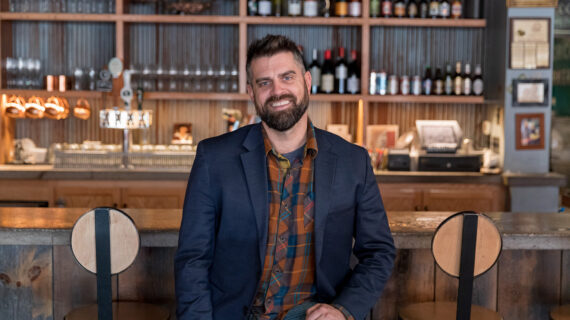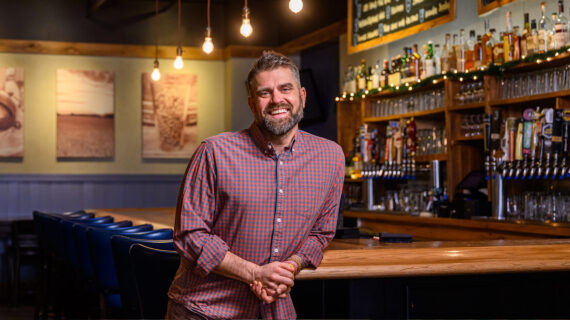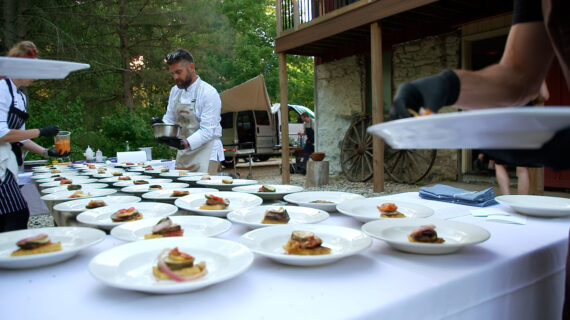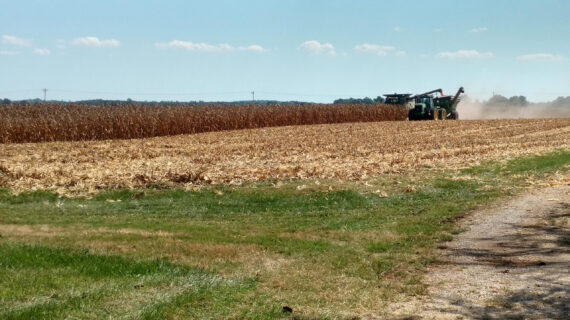– Luke Zahm: This week on Wisconsin Foodie: We’re headed to Ahan, one of Madison’s hottest plates.
– Hello, my name is Jamie Brown-Soukaseume.
So here at Ahan, we serve primarily Lao, Thai, Vietnamese food.
We try to stick to, like, the most authentic flavors.
– Luke: Oh, my gosh, this looks gorgeous.
– Jamie: So the Khao Soi Luang Prabang, that is a recipe passed down from my mother’s grandmother.
– Luke: Man, that broth is so rich and satisfying.
– Jamie: So here we have the Lao marinated roasted chicken.
– Luke: Or we could, like, you know, pretend we’re at the Renaissance Faire and just like– – Jamie: Yeah, and just pick it up?
Yeah, you can do that.
That’s what they would probably do in Laos, too.
– That’s so good.
It’s delicious.
What?!
It’s a flavor bomb, my goodness.
It’s like everything you want in a bite.
– Jamie: Okay, so, yeah, this is beef laap.
It’s the national dish of Laos.
– Luke: I love, like, the visceral connection, like, actually using your hands.
– Jamie: Mm-hmm.
– Luke: It’s phenomenal.
I hope it never goes away.
A Laotian perspective.
A Wisconsin perspective.
[gentle music] Wisconsin Foodie would like to thank the following underwriters.
[gentle music] – Did you know Organic Valley protects over 400,000 acres of organic farmland?
So, are we an organic food cooperative that protects land, or land conservationists who make delicious food?
Yes; yes, we are.
Organic Valley.
– Twenty-minute commutes.
Weekends on the lake.
Warm welcomes and exciting career opportunities, not to mention all the great food!
There’s a lot to look forward to in Wisconsin.
Learn more at InWisconsin.com.
– Employee-owned New Glarus Brewing Company has been brewing and bottling beer for their friends, only in Wisconsin, since 1993.
Just a short drive from Madison, come visit Swissconsin and see where your beer’s made.
– For generations, our bacon recipe has remained the same.
You can see it on our labels, smell it as you cook it, and taste it in every bite.
[bacon sizzling] Breakfast better with Jones.
– The Wisconsin Potato and Vegetable Growers are proud underwriters of Wisconsin Foodie.
It takes love of the land and generations of farming know-how to nurture a quality potato crop.
Ask any potato farmer and they’ll tell you, there’s a lot of satisfaction in healthy-grown crops.
– With additional support coming from the Conscious Carnivore.
From local animal sourcing to on-site, high-quality butchering and packaging, the Conscious Carnivore can ensure organically raised, grass-fed, and healthy meats through its small group of local farmers.
The Conscious Carnivore: Know your farmer, love your butcher.
– Also, with the support of the Friends of PBS Wisconsin.
[bright, driven folk pop music] – Luke: We are a collection of the finest farmers, food producers, and chefs on the planet.
We are a merging of cultures and ideas, shaped by this land.
[sizzling] We are a gathering of the waters, and together, we shape a new identity to carry us into the future.
[glasses clinking] We are storytellers.
We are Wisconsin Foodie.
[gentle music] Today, I’m in Madison and I’m on my way to one of one of my favorite restaurants, Ahan.
Chef Jamie has combined so many cultural elements.
Growing up in Beaver Dam, having a mother who’s a Laotian refugee, and culminated them into one of Madison’s hottest plates.
For the flavors of Southeast Asia and the historical perspective of Laos, we’re headed to Ahan.
[bright music] – Jamie: Hello, my name is Jamie Brown-Soukaseume.
So here at Ahan, we serve primarily Southeast Asian food, primarily Lao, Thai, Vietnamese food.
So I grew up on a Lao household.
My mom and dad are both Lao and Chinese.
As, like, a child, my parents owned a Chinese restaurant in La Crosse.
So I grew up there, and I grew up at– Some of my family owned, like, Chinese-American restaurant in Beaver Dam.
So I always grew up in the restaurant, you know, wanting to prep food, helping with packing carry-outs.
I was always just running around restaurants, you know, ever since I was, like, three years old.
That’s where mainly all my cooking background is from.
My mom, she’s, yeah, she’s definitely one of my biggest influences.
You know, I always say she’s one of my favorite chefs.
She’s been cooking for, like, almost 40 years.
She, like, has become more creative, it seems like, too, as well.
When my mom’s here in town, she is very much involved in the kitchen.
She loves being in the kitchen, she loves cooking.
When she doesn’t work, she cooks all the time.
Like, we’ll go to her house on, like, on Mondays and Tuesdays and whatnot.
She’ll already have, like, a full meal ready to go.
Like, she loves cooking food here.
She loves being in a restaurant setting.
She’s, you know, cooked professionally for 37 years.
She loves coming out here to talk to guests.
She loves that.
She’s kind of like everyone’s mom in the kitchen, too.
Like, you know, all the boys in the kitchen.
She’s, like, kind of like, shoots them, like– She always says, like, “You’re my son, too.”
Like, she always says that.
[chuckles] She’s really inspired me by, you know, the different flavors she’ll use.
She’ll go to Laos, come back, tell me what she’s seen at the night market.
You know, she’ll show me how they used to do things in Laos before.
And then I’ll show her how, you know, how we’ve been plating or cutting things here, you know, and she’ll learn a lot.
And, you know, we kind of just inspire each other and work with each other so well ’cause there’s just two different worlds that are coming together.
Lao food, yeah, the flavors are very bold, you know, very pungent, intense.
You know, we have a lot of citrus, fish, shrimp paste, like, they’re very intense flavors.
But somehow she gets them all to balance out.
You know, you have the sweet, spicy, fishy, sour, like all those things, somehow she can balance all out, you know?
And it’s just amazing to me.
Yeah, I think, you know, Hmong food and Lao food are very similar ’cause we come from, like, Lao.
Hmong people are also from Laos as well.
They also come from, you know, China, Vietnam, Thailand.
So they have a little bit of everything, all the influences.
So the food I would say is very similar.
So I think like, you know, the flavors still remain very, like, intense and pungent, and like, bold, in Hmong food.
It’s very, very similar to Lao food.
I think in Vietnamese food, they do have some of those intense flavors, but some of them are a little bit, I think, more subtle, you know?
We try to stick to like, the most authentic flavors, you know?
Like we still serve our, like, papaya salad Lao-style.
So we put, like, the crab paste, the shrimp paste, the fish sauce.
We still make it very, like, you know, intense and Lao style.
Some places I know, they’ll kind of, like, dull that down.
But, so we do that.
But then we’ll also serve it with, like, you know, fresh cucumbers, some fried chicken and, like, plate it really nicely and make it presentable, make people, like, not so scared to try it, you know?
Like, they might hear, like, shrimp paste and, like, crab paste and they might be afraid to try it.
But I think if you make it in a way that’s, like, presentable and, like, kind of just influence people to try it, you know, they’ll like it, I think, you know?
Yeah, I definitely always try to keep up with, you know, utilizing a farmers’ market, buying from local purveyors until this day because I just, like, it really inspires me to go to the market, see what’s in season, see all the fresh items that are there, speak to the farmers, see what they can, you know, present to us.
And then we also have created very good relationships with our farmers where, you know, I will text them so we can go pick things up because we have, you know, a pretty busy day-to-day.
So they’ll like, you know, text me what they have, you know, whether it’s a list, photos, et cetera.
or I’ll get emails from farmers as well.
You know, like, “Hey, this is what we have this week.”
And, you know, it’s just really cool to hear ahead of time, what we’re gonna have and be able to just create that kind of relationship where they’ll set things aside for us and know what we like and know what we need, you know?
[bright string music] So yeah, we’re headed to the Wednesday market.
All right, so we’ve got 12 to 15 heads of cauliflower.
We’ve got 60 pounds of zucchini.
We’ve got a 20 to 30 pounds of broccoli and all that.
Oh, this is Heather from Green Barn Farm.
It’s out of Ripon, Wisconsin.
– Heather: Yep.
– Jamie: Not too far from here.
But Heather provides with tons of amazing produce.
Yeah, like we said, we get the majority of our lettuce there, zucchini, broccoli, cauliflower, Roma tomatoes.
– They’re very, very supportive of local farmers.
I really appreciate them.
– Chuckie Brown-Soukaseume: You got the good stuff.
– Thanks, guys.
Your food is phenomenal.
– Chuckie: Thank you.
Cool, all right.
– Jamie: Yeah, we’re gonna get a couple more things as well.
So we’re at the Wednesday Dane County’s farmers’ market.
It’s right off of MLK Boulevard.
It’s right off the Square.
It’s a smaller market.
There’s probably about, I would say, 15 vendors here.
There’s a variety of vendors.
There’s produce, flowers, cheese, some meat, and also honey from Mary.
Mary is the bee charmer.
We use all honey from her.
– Chuckie: Could we, please, get four jars, and then, yeah, we’ll do one bee pollen.
Mary: Okay, awesome.
– Chuckie: Yeah.
– Jamie: Yeah, this is bee pollen.
Mary says if you have, like, five a day, that really helps with your allergies.
It’s kind of crazy, it has, like, this really concentrated taste of, like… – Yeah, we’ll do one bee pollen.
– Mary: Okay.
– You know, like honey.
– Mary: Familiar with my black locust comb honey?
– Jamie: Yeah, we can definitely get some black locust.
This is Manola’s favorite, too.
That’s one of her favorites.
She drinks that with her tea every day.
– Mary: Oh, good for you.
It’s healthy.
– Jamie: [chuckles] Yeah.
Yeah, I get a lot of inspiration from the farmers’ market.
There’s sometimes, like, you know, items that I forget that are gonna be in season or just, sometimes I see something new or something that might have not been used in a dish before that’s Southeast Asian, technically.
But I kind of think of the flavors when I see ’em and all the colors and thinking about how I could utilize that, you know, in something that I ate growing up.
She got very excited.
That’s a Lao basil.
Me too.
What’s the type of Thai basil?
It’s called a– We call it pak i tou.
It’s like a Lao, Lao basil.
It’s hard to find this specific variety of basil.
This is really, like, special to her.
We’ll get something from this bakery, too.
The croissants are really good.
I had them– Hi, how are you?
Yeah, one Kouign-amann.
Oh, you want that one?
You want the one– – Manola Hoang: Yeah, I like the big one, look, right there.
– Baker: Oh, you want– – I say the big.
Not the same size.
I like big.
[all laughing] – Jamie: Oh, yeah, my mom, she loves American food as well.
She loves, like, she loves pastries.
She loves croissants.
She discovered a new croissant today, the Kouign-amann, she loves that.
So we gotta get back to the restaurant.
It’s getting 10:30 right now, we open at noon.
So this is– Usually, we’re like, when we’re in a rush, we usually stop and get a snack.
And then we gotta rush back to the restaurant, so.
The most benefit of using the produce at farmers’ market, for me, the chef, is all of it’s so fresh.
All of it’s grown within, you know, you know, within the, like, 200 miles of here.
Everything’s so fresh.
It’s not like the same as ordering something from a bigger purveyor that’s coming across the country.
Like, everything is literally just, you know, picked from the ground or just off from the tree, like, you know, in the last week.
Food is a very big part of, like, you know, our culture, Asian American culture, whether it be Lao American, Hmong American, Vietnamese American, it really brings everyone together.
And no matter when there’s a gathering, there’s always a lot of food whether it’s, like, a wedding, you know, someone’s had a baby, a funeral, anything like that.
Like any big gathering, there’s always tons of food, you know, like.
And, you know, everyone’s gonna make more food than we need at all times.
They want people to bring home food, like, there, like…
It’s always something to talk about that people share recipes.
You know, they share what they put in their pho versus what somebody else put in their pho.
It’s always, like, a huge talking point, and, like, what brings people together, I would say.
[gentle music] – Luke: Oh, my gosh, this is beautiful.
– These are the veggies for the khao soi and the crispy rice that we make in house.
– Luke: Yeah!
– Jamie: Chili oil.
And this is the khao soi Luang Prabang with wide noodles.
– This looks gorgeous.
And it smells so rich and, like, fortifying.
I can’t even begin to comprehend.
Tell me a little bit about this dish.
– So the khao soi Luang Prabang, that is a recipe passed down from my mother’s grandmother.
– Luke: Okay.
– Jamie: So, what it is, is it starts as a base with, like, tomatoes that we cooked down with ground pork, fermented beans, you know, some salt, sugar.
And then we end up adding, like, fish sauce to it when we pour the broth in.
– Sure.
– So basically, we make the base with all the tomatoes and pork, and we kind of, like, let everything cook down and, like, you know, create all these wonderful flavors.
And then we use that, we make that base ahead of time.
And then for service, we warm the base up, put it with the noodles, then add the broth to it.
– Nice, that sounds like a banger.
– Jamie: Yeah, it’s, yeah, it’s just so many different flavors together and, like, you know, the pork and the tomatoes and the fish sauce, like, go so well together.
– Luke: Yeah!
– Jamie: Yeah.
So this basil we picked up at the farmers’ market today.
My mom picked out her own basil.
She was talking to them about this.
She got really excited ’cause they had a– It’s a smaller leaf Thai basil, and they call it pak i tou, so it’s a Lao basil.
You can’t always find that, you know.
[groovy music] – Like, I get a little bit of the richness of the tomato.
You know, that sweet backbone, that is reminiscent of, like, so many cultures of food, but with the added element of the fish sauce and the heat and the noodle.
And then you get the basil, so good.
– And you get, like, the fresh with the spicy.
– Man, that broth is so rich.
I mean, it’s rich and satisfying.
You get, like, a little bit of that tomato backbone.
You get some of the heat.
You get, obviously, the herbaceous nature with the basil and all the aromatics.
And you get that crazy umami that I think only fish sauce can really provide, you know.
And I know that there are other ways to kind of work around it.
Some people, you know, have an aversion to it, but honestly, it’s like one of those ingredients that’s so ubiquitous in, like, so much food, like, across different cultures.
Worcestershire, fish sauce, you know, that little bit of umami base, it just sings on my palate.
And, like, the addition of the chili oil with the jalapeos, all that in there, you know, the heat.
This is really, really good.
– Jamie: I’ve had, like, even a mother come in here with her kids.
They go to UW and they’re from– she’s, like, from Burma.
And she’s like, “You know, we expected this to be more Americanized and stuff.”
And she was like, “The flavors are so authentic, but everything is, you know, very beautiful.”
And she’s like, “It just reminds me of home.
It reminds my kids of home.”
And she was like, “We’re very happy that you’re here.
“So they can have that while they’re, you know, in town studying.”
– Kili McGeorge: Lao platter for you guys.
– Oh, man, thank you Kili.
– Jamie: Thank you, chef.
So here we have the Lao marinated roasted chicken.
We get our chicken from Stack Farms.
– Luke: Cool.
– Jamie: We have a lemongrass Lao sausage.
We have the jeow mak len, which is a roasted tomato sauce.
So today, we picked up all those tomatoes from Heather at the market.
Sticky rice is at every, like, every meal in Laos.
Like, they have sticky rice and they have some sort of dipping sauce that they call jeow.
– Okay.
– It’s usually some kind of vegetable with chili and garlic and fish sauce pounded together.
And they dip their sticky rice in there.
They have their meat and the veggies, and they just use that as a vessel, yep.
– It’s amazing, it’s almost like a utensil.
– You can open this up, too.
– Yeah.
– Yeah, it’s like they use– like, mostly eat everything with their hands, you know, unless it’s soup.
– Talk me through, like, how you approach a Lao platter.
– For this dish, you know, I would, like, I would take some of the veggies, probably take some of the, I would take the lime and just, like, squeeze it all over the chicken.
Get that really good.
– Oh, my God, that is so good.
– And then you can kind of use the cabbage as like a vessel, too.
– Yeah.
– You can grab that.
You can grab some sausage.
– Mm-hmm.
– You can grab your sticky rice.
– Yeah.
You can, like, take some chicken.
Just cut some of that off, you know.
– Sure.
Or we could, like, you know, pretend we’re at the Renaissance faire.
– Yeah, and just pick it up?
Yeah, you can do that.
That’s what they would probably do in Laos, too.
And then you’re gonna take your jeow.
You can take your sticky rice and just dip that in there.
– Okay.
– Yep, eat that.
Kind of wrap everything in your veggies.
– Yeah.
– Let’s do that.
– Like, the flavors of jeow.
Like, can you talk me through, like, what is it consistently?
– Jeow is always chili, garlic, shallot, fish sauce, and sugar.
And then, like, they roast everything, like, in the, like, on a grill or open fire.
You know, that’s what they usually do.
We sometimes put stuff in the oven.
And you just pound it in a mortar and pestle all together until all the flavors kind of mush together.
– Nice.
– And it kind of like, puts all the flavors together.
You kind of get this, like, kind of like this, rustic, like, salsa-looking thing, you know?
And then, yeah, you can put anything in your jeow.
You can put tomatoes.
Sometimes they use roasted Thai eggplants, sometimes it’s just chilies.
Sometimes there’s like fermented shrimp, fermented chili, fermented bean.
Like, anything, yeah.
– For sure.
So it’s like this ubiquitous kind of cover all, like, for dipping sauce.
– Yes, exactly.
– Awesome.
– So jeow is just like, you know, the name of, like– Jeow mak len means tomato, tomato sauce, tomato jeow.
You can say, jeow mak keua means, like, eggplant jeow.
– Mm-hmm.
Talk to me about the marinade on the chicken, would you, please.
– The chicken, so we have a lot of ginger in there, lemongrass, garlic.
We use, a lot of times, we use Golden Mountain seasoning sauce.
– Okay, yep.
– Yep.
We let that marinade, you know, at least overnight.
And then we, we’ll, like, pre-roast them and then we’ll pick ’em up again for service.
But, yeah, that’s how we get, like, that really crispy skin, too.
– That’s so good.
Mmm, it’s delicious.
– But just like the– All that just like kind of really permeates into the skin really well.
And you get this really, like, kind of like intense crunchy flavor on the outside, but it’s subtle on the inside.
You can still taste like, you know, the deliciousness of the chicken.
– Yeah, right, it’s rich, it’s fortified.
– Mm-hmm.
– You get a little bit of that push-pull between, you know, I have lime on mine I think now.
But the sugar, the salt, all that rich roundness.
– Yep, and it’s not too intense dipping it with the tomato, you know?
– Yeah, it’s legit.
[gentle music] Oh, my gosh, I’m so excited.
Every time I come here, I, like, eat way too much food.
And then I– It takes me the drive home to, like, get over the belly ache because, like, I try everything, oh, my gosh.
– Jamie: I know, that’s tradition.
That’s like every Lao household here.
You leave, like, so full.
Kili’s been to my mom’s house, he knows.
– Luke: Really?
– Kili: Nonstop.
– Jamie: Nonstop eating.
– It’s nonstop?
– Kili: Nonstop.
– You can’t stop eating either.
– What?!
This is gorgeous.
Thank you.
– Manola: [speaking Lao] – Yeah, sit right here.
– It certainly seems like it doesn’t get more Lao than this, honestly, and for good reason.
This place is on fire.
I’m so thrilled to be able to take a little time with you.
Thank you for coming out and, like, hanging out.
– Jamie: Yeah, thank you.
– Luke: Yeah, and I can’t wait.
What’s your first bite?
What’s your first bite here, Jamie?
– I would say, I would eat these while they’re still hot.
– Okay, okay, cool.
– First, try son-in-law eggs.
Yep, yeah, even my cousin’s wedding, she brought a whole tray of son-in-law eggs.
– Luke: Really?
– Jamie: Laos wedding, yeah.
It’s kind of like crispy, crunchy.
– Whoa.
– Manola: Good flavor?
– Yeah, it’s delicious.
It’s a flavor bomb.
[Jamie laughs] I mean, with the yolk mixed in, the bean thread noodles.
Is there pork in there, too?
– Pork, yeah, have pork, mm-hmm.
– Pork, yeah.
– It’s like a pork sausage that we mix with the bean thread noodles.
– My goodness, it’s like everything you want in a bite, you know, crispy, soft.
Texturally, it’s very rich, kind of creamy in that middle.
You get a little bit of interesting variety with the bean thread noodles and then the pork with a little bit of chew.
And I started with the sweet chili sauce.
That was dynamite, I’m gonna go for the jeow.
– Manola: Yeah, yeah, then go jeow.
– Jamie: That’ll be good.
– Luke: Yeah.
– Jamie: She said, that’s kind of like a old, lost food.
She said not a lot of people make that anymore.
And she said it’s kind of hard to find, you know, even in Laos, she said, like, because it’s, like, it takes time, you know, to make it.
– Luke: For sure.
– You go now to Laos, nobody make it like that.
[Jamie chuckling] When you go Laos.
– Except for you two.
– Not like this.
– Yeah, exactly.
It’s phenomenal.
I hope it never goes away, at least here.
– Yeah, I don’t think it’ll go away here.
Okay, so, yeah, this is beef laap.
It’s a national dish of Laos.
So this is, like, one of the most important dishes.
The main dish there, it’s got a lot of herbs.
The thinly rare sliced beef with the toasted sticky rice powders.
And then they kind of just mix that together like a big salad.
And you kind of eat that the same way we ate the chicken, with the sticky rice and cabbage as a vessel.
– Mm-hmm, I love, like… – Eat the honeycomb tripe in there, too.
– Luke: Really?
Oh, it’s so good.
I love, like, the visceral connection.
Like, actually using your hands.
– Mm-hmm.
– I think that that makes a really fun and satisfying dining experience.
– Jamie: Definitely.
– Luke: Mmm.
– Jamie: So, and then this is the tam mak hoong, the Lao-style papaya salad.
So where she comes from, there’s a place that just makes a bunch of papaya salad.
All they make is papaya salad.
And that’s where the Luang Prabang style, they do those wide strips.
And like a lot of places, you don’t see those wide strips like that.
Then we have the snake beans, cherry tomatoes from Vitruvian Farms.
We serve it with our lemongrass fried chicken, which we’ve become known for here.
– Luke: Yeah.
– So it’s like chicken thighs marinated in lemongrass, turmeric, you know, sugar, salt, pepper.
And then we fry it in this really delicious crispy dip.
– Luke: Yeah.
– Yep, and then some pork rinds, some fresh veggies from the market, and then the Lao-style papaya salad.
– Luke: Sure.
So that wide noodle or like, the wide grade.
That’s indicative of, yeah.
– Manola: Luang Prabang.
– Yeah, of her hometown, Luang Prabang, yeah.
– Okay.
– Jamie: Luang Prabang is a smaller town.
It’s gotten more touristy now, but there’s all the waterfalls, and, like, the temples that are up high.
– How much did your mom being a cook, influence your decision to become a cook?
– Oh, I guess at first it was like– At first it was like she didn’t want me to cook, you know?
I didn’t really think about cooking, you know, ’cause that’s kind of just what she did as a job to survive, you know?
– Yeah, right.
– You know, like, they’re, like, go into school, like, do this and that, you know.
So at first, it was like an anti-influence, you know, like, “You don’t wanna do this.
“We had to do it because we have nothing better to do.
“We can’t do anything else.
“So we just moved to this country.
This is what we have to do to survive.”
But then, you know, growing up and I think just seeing her cook and just like, getting to really love food, it really inspired me, you know, and getting to work with her.
– Luke: Yeah.
– So at first it was like, you know, I’ve said this before, it’s like, I never really thought about food in this way until I started cooking professionally, you know, when I was 20.
I used to just see as, you know, cooking and people being chefs and cooks as a survival thing, you know?
– Yeah.
– Like, they came here, they don’t know the language, and they only do this because this is what they are– This is what is available for them to do.
– Sure.
– That they can make a living.
I never really looked at it as a creative outlook.
You know what I mean?
– Yeah.
– I never thought of it as something that I could do for, you know, fulfill any creative desire or anything like that, you know?
– Mm-hmm, mm-hmm.
You’re doing an amazing job.
– Thank you.
– You have the perspective, this dual perspective that’s beautiful, right?
A Laotian perspective, a Wisconsin perspective.
– Yeah, but yeah, speaking of that, you know, I love to see her in this era where she gets to be creative with her food and she’s not doing it for survival anymore.
– Right?
– She can have fun, you know.
– Right, exactly.
– It’s just so beautiful to see that part.
– Totally, you’ve done an amazing job.
You’re doing an amazing job.
– Thank you.
– It’s really incredible to see your story, your struggle, and your triumph all merged together on these plates.
I mean, it truly is incredible.
– Well, thank you so much.
And we appreciate you coming here.
You know, it’s a special place to us, and we’re happy to share it with you guys.
And, yeah.
– I’ll be back, it’ll be great.
– Yeah, thank you.
– Luke: Mmm.
I love this.
– Yeah.
– This is good.
[groovy music] – I think, like, a lot of Asian Americans, you know, especially my, like, first generation, now that we’re opening restaurants and stuff, do feel a lot of pressure to Americanize things because the generation before us did really have to do that, because people didn’t feel like, you know, our flavors were gonna lend well to American palates, you know?
But I think now, you know, the pressure has gone away a little bit because the people are a little bit more adventurous about eating, which I really, really appreciate.
And I love that, and my mom loves that too.
She’s, you know, so amazed by the things people will eat here, you know.
And I grew up in a small town and like, people aren’t adventurous at all.
But like, she, like, just loves it here.
Like, everyone appreciates her food and my food and…
But, you know, there’s always that little thing, like, “Should we make it that spicy?”
like… And my mom’s like, “Are you sure that’s not too spicy?”
I’m like, “No, I think people will eat it,” like, you know.
[gentle music] – Did you know Organic Valley protects over 400,000 acres of organic farmland?
So are we an organic food cooperative that protects land, or land conservationists who make delicious food?
Yes; yes, we are.
Organic Valley.
– Twenty-minute commutes.
Weekends on the lake.
Warm welcomes and exciting career opportunities.
Not to mention all the great food!
There’s a lot to look forward to in Wisconsin.
Learn more at InWisconsin.com.
– Employee-owned New Glarus Brewing Company has been brewing and bottling beer for their friends, only in Wisconsin, since 1993.
Just a short drive from Madison, come visit Swissconsin and see where your beer’s made.
– For generations, our bacon recipe has remained the same.
You can see it on our labels, smell it as you cook it, and taste it in every bite.
[bacon sizzling] Breakfast better with Jones.
– The Wisconsin Potato and Vegetable Growers are proud underwriters of Wisconsin Foodie.
It takes love of the land and generations of farming know-how to nurture a quality potato crop.
Ask any potato farmer and they’ll tell you, there’s a lot of satisfaction in healthy-grown crops.
– With additional support coming from the Conscious Carnivore.
From local animal sourcing to on-site, high-quality butchering and packaging, the Conscious Carnivore can ensure organically raised, grass-fed, and healthy meats through its small group of local farmers.
The Conscious Carnivore: Know your farmer, love your butcher.
Also with the support of the Friends of PBS Wisconsin.
– Luke: Still hungry for more?
Search Episodes
Related Stories from PBS Wisconsin's Blog

Donate to sign up. Activate and sign in to Passport. It's that easy to help PBS Wisconsin serve your community through media that educates, inspires, and entertains.
Make your membership gift today
Only for new users: Activate Passport using your code or email address
Already a member?
Look up my account
Need some help? Go to FAQ or visit PBS Passport Help
Need help accessing PBS Wisconsin anywhere?

Online Access | Platform & Device Access | Cable or Satellite Access | Over-The-Air Access
Visit Access Guide
Need help accessing PBS Wisconsin anywhere?

Visit Our
Live TV Access Guide
Online AccessPlatform & Device Access
Cable or Satellite Access
Over-The-Air Access
Visit Access Guide
 Passport
Passport


















Follow Us